A beautiful hike in Nameri National Park
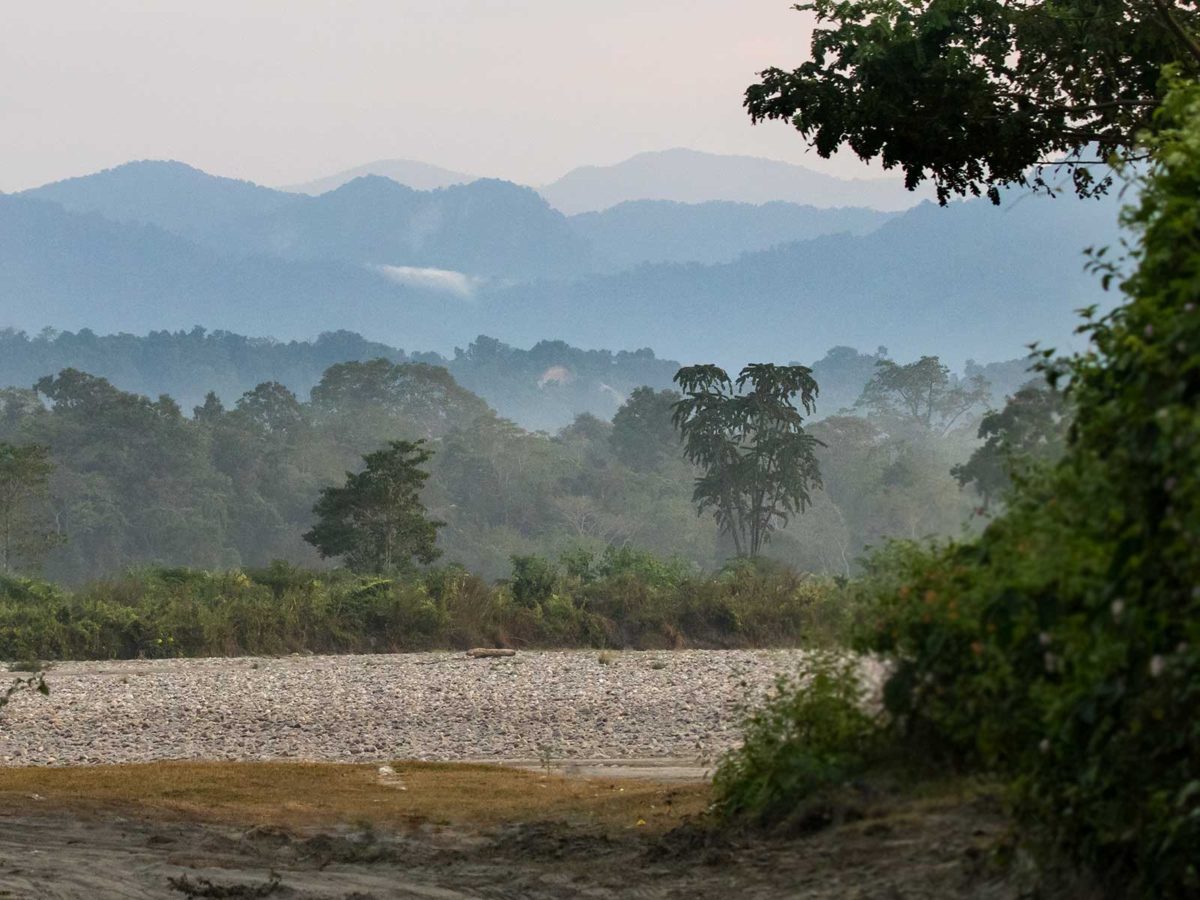
Nameri National Park in misty morning! I really loved the scenic view of this park .
Nameri national park is located at the foothills of the Eastern Himalayas. The nearest town Tezpur is 35 kms far from Nameri. We heard Nameri National Park is excellent for birding and decided to visit this place during our North-east Trip. The main river of Nameri is Jia- Bhoroli which flows along the Southern boundary of the park.
We were roaming around North-eastern part of India in a self drive rental car and we reached Tezpur Brahmaputra bridge very early morning. We saw the enormous Brahmaputra river with awe and continued our drive to Nameri. We had booked a resort in Nameri and without much hassle we reached the place. We visited the place in non-tourist season, so the resort was empty. The resort employee accompanied us to the forest booking office where we were supposed to do the payment for the trekking inside Nameri National Park. While we were waiting for the forest officials to open the counter, we started hearing the beautiful morning chirp-chirps of birds. We saw Grey-headed green pigeons perched silently and a Blue-throated barbet continuously calling from a dead tree. Then there were sudden movements in a nearby tree and we saw a group of Capped Langur coming for their morning work. They were jumping from one branch to another in a flurry of activity but a few sat and watched us curiously.
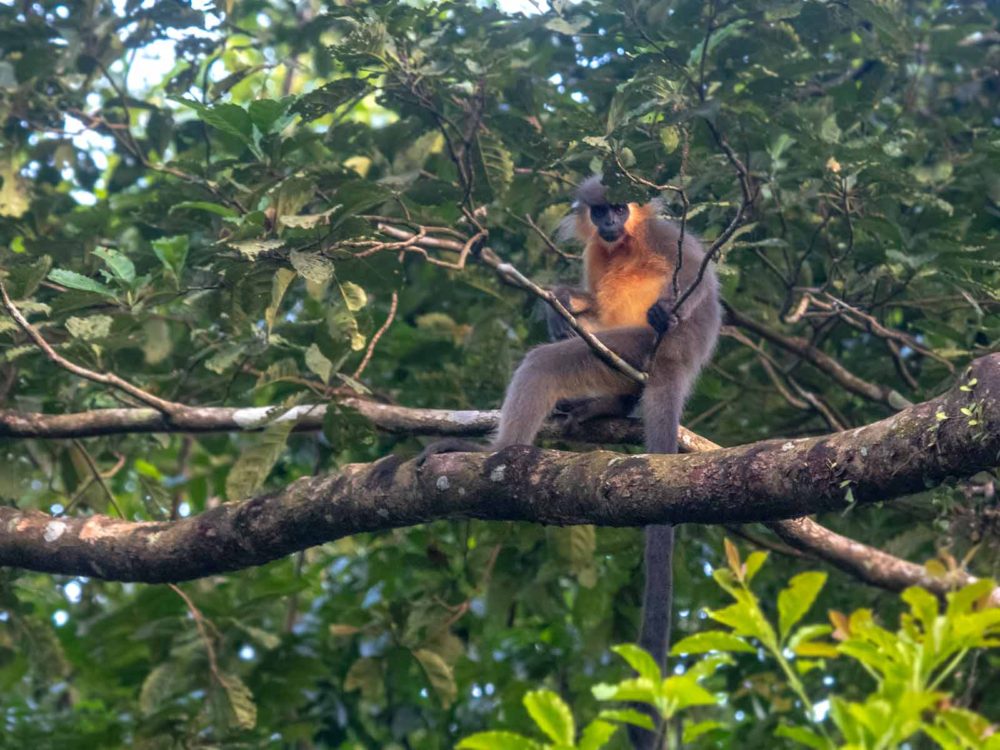
The Capped Langurs are arboreal and gregarious by nature. They live in subtropical and montane forests rich in vegetation and freshwater streams. The species is named for the thick hair on the top of their head that is usually black or gray.
The Capped Langurs are herbivorous and like most mammals in India , threatened by habitat loss. In India these Langurs are found only in North-eastern part of India. We were very excited to see this Capped Langur and joyously got ready for the trekking after paying the fee in the forest office.
An armed guard accompanied us and we drove to the place where the boat persons were waiting for us. We parked our vehicle and while Vinod was grabbing the camera stuffs from the car, four ducks flew across the river. Vinod was screaming “White-winged Duck” and quickly took his camera but not quick enough. Even though we both saw the flight of the endangered White-winged duck which was seen only in North-eastern region of India, we were not satisfied with our sighting. Like I always say, we don’t do checklist birding or rare birds searching and we always feel sad, guilty when we see an endangered species. But when the duck just flew infront of our face and we couldn’t admire them enough, we were bit upset. We packed our bags and then only we looked at our surroundings closely. The scenic view was mind blowing and we could see Himalayas at distance.
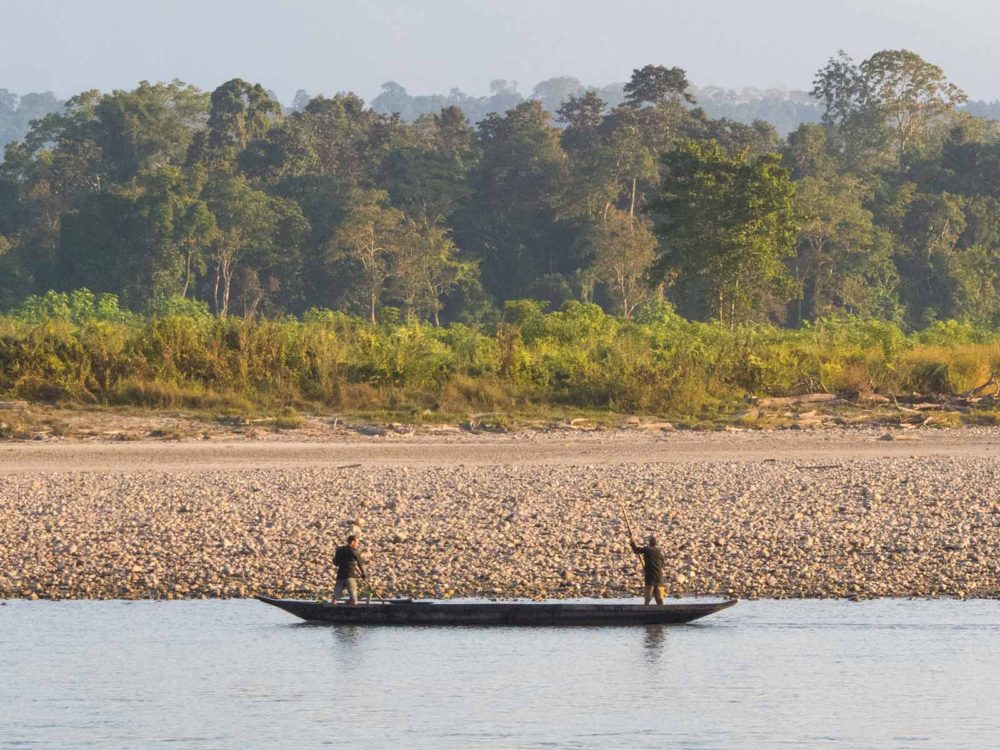
The sight of the boat, pebbles and old forest growth increased our enthusiasm to go inside the park and explore. The river side used by humans were filthy and the side used by wildlife were pure to the core!
The Jia-Bhoroli river was flowing with less but pure water and the river looked very beautiful with pebbles. We enjoyed the boat ride while searching for Ibis bill.
We set our foot at Nameri National Park and within few minutes I spotted Lesser Yellownape Woodpecker. The guard warned us to be silent as there are elephants in this area. So we walked in silence even though we were very excited by the sightings infront of us. The vegetation were totally different from what we had seen in other Indian forests. As we crossed the river and came to the park which had no human inhabitants, it felt like we were in an island. The melodies of birds were very different from what we heard in the other side of the river. It sounded like the birds were more liberal when there was no human settlement. A flock of Scarlet minivet made the sky colorful and the Lineated barbet was calling around. Butterfly activities also had started and we were excited to see many new butterflies. The North-eastern regions are the butterfly hotspots in India.
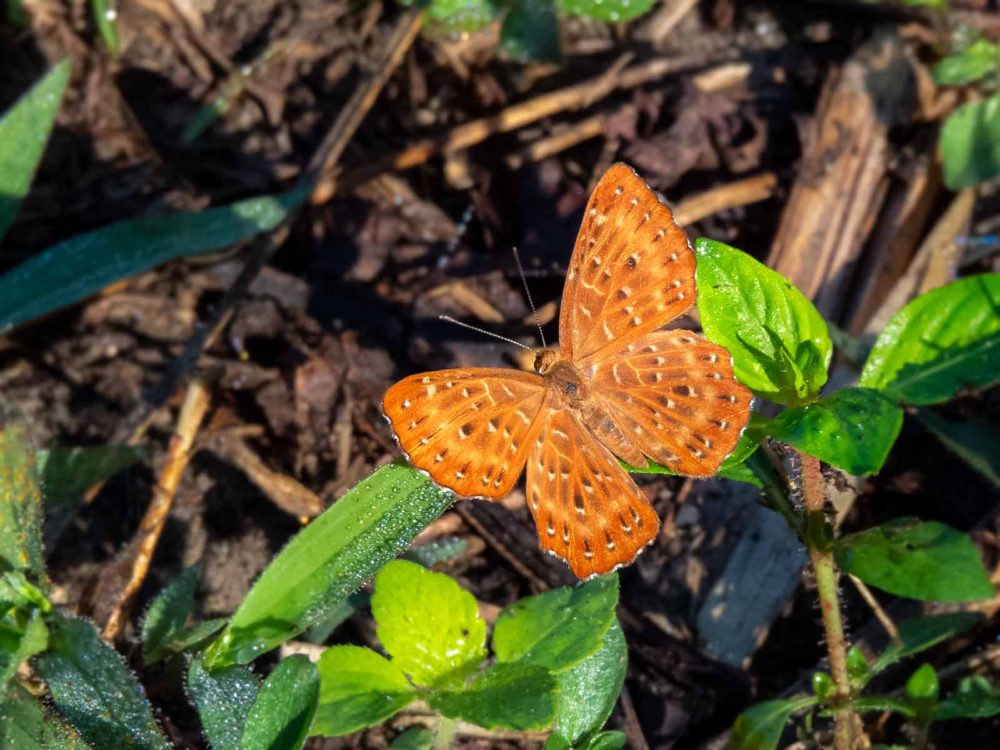
Himalayan Punchinello is one of the beautiful butterflies found in South and Southeast Asia. The morning light brought out the enticing colors of the butterfly.
The butterflies are much diverse compared to the ones we see in South India. The guard was surprised to see us stop for birds, butterflies and wildflowers and understood we were not regular tourists. So he also started explaining us about the trees and the importance of protecting this national park.
The Bauhinia purpurea was in full bloom in Assam and the blossomed trees inside the Nameri National Park looked more beautiful than the ones we saw on the roadsides. While we were enjoying the little things in the park, the guard told us to stop and watched the surroundings keenly. He showed us the foraging elephant herd and we also saw two elephant calves in the herd. We heard this area had huge human-animal conflict which caused many elephant deaths. It looked like atleast inside the park they had some peace. We continued our stride without disturbing the herd. The path was wide open and the butterflies were fluttering around but we quickly crossed that section after seeing the elephants.
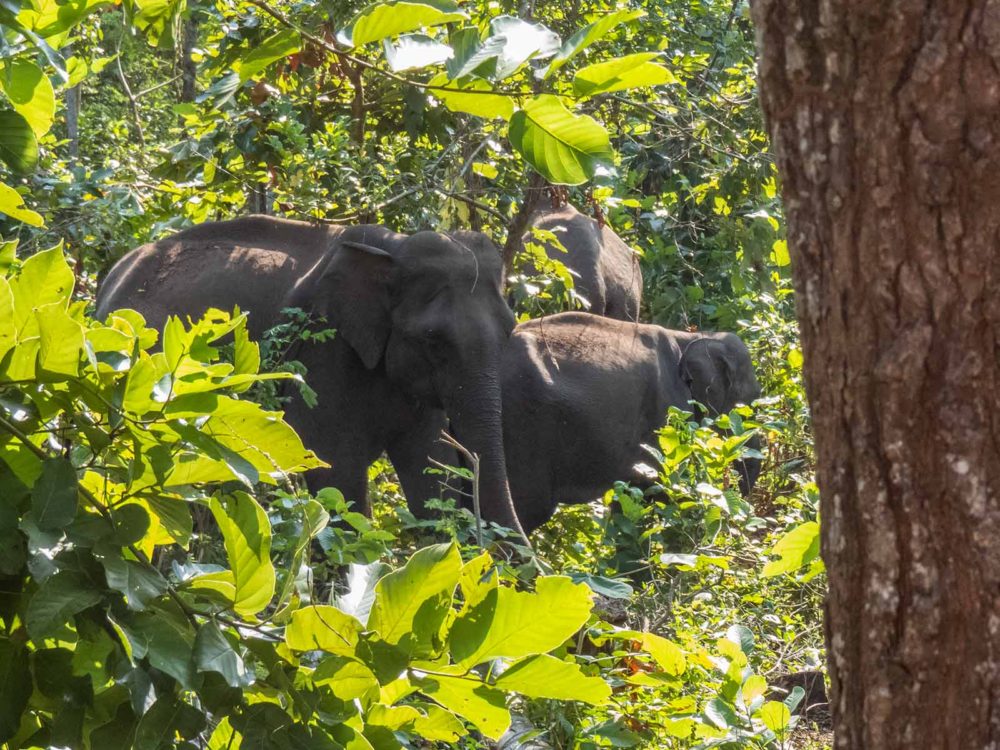
Elephants are our favorite animals and seeing them always make us feel happy. In recent years, they had lost their glory and were treated very cruelly by humans. The human-animal conflict keeps on increasing and the elephants are suffering a great loss.
We reached a watch tower and from the tower we had a good look of the park. The Imperial pigeons were flying around in big flocks and few were sitting on a distant tree. We watched their beautiful flight for sometime.
We went in summer season, so there were not many wildflowers. So I just looked at the common wildflowers and continued the walk. Vinod stopped suddenly and told me there was an orchid on the tree. I thought he was messing with me as I was grumbling that as a wildflower lover it would be a shame to return from a North-east trip without seeing several orchids. But he showed me an orchid plant on a tall tree and my first thought was the plant was not in bloom. Then Vinod took some pictures and showed me the tiny orchid blooms. It was Acampe carinata (Keeled Acampe) ! The details of the flowers were not clearly visible for the naked eye.
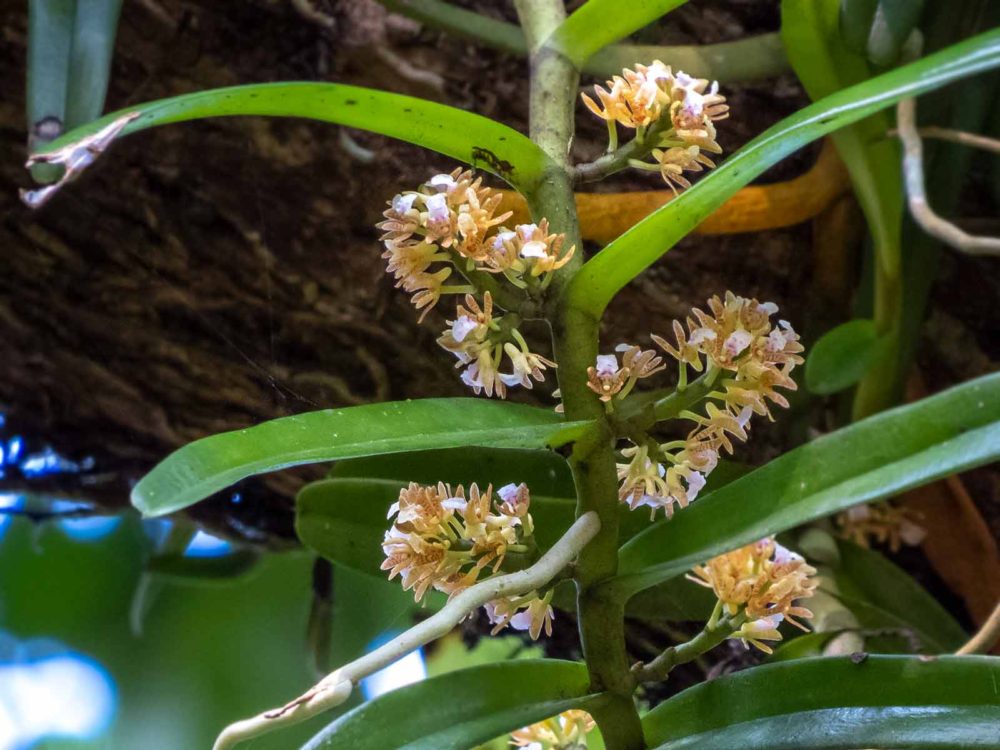
Keeled Acampe is an epiphyte orchid. The floral pattern looked very intrinsic!
Only after Vinod showed me the photo, I saw the designs of that beautiful orchid clearly and the guard was happy to see the flower which he had never noticed previously. As the Sun went high, the birds activities had started slowing down but we heard the chitter-chatter of parakeets nearby. We spotted the tree where the parakeets were having their meeting and the parakeets we saw were Red-breasted Parakeet. The population of these parakeets are also in decline and that was the first time we had seen Red-breasted Parakeet. We continued walking in the trail which was surrounded by thick vegetation. Even in summer season the park looked very much green!
Nameri National Park Walking Path
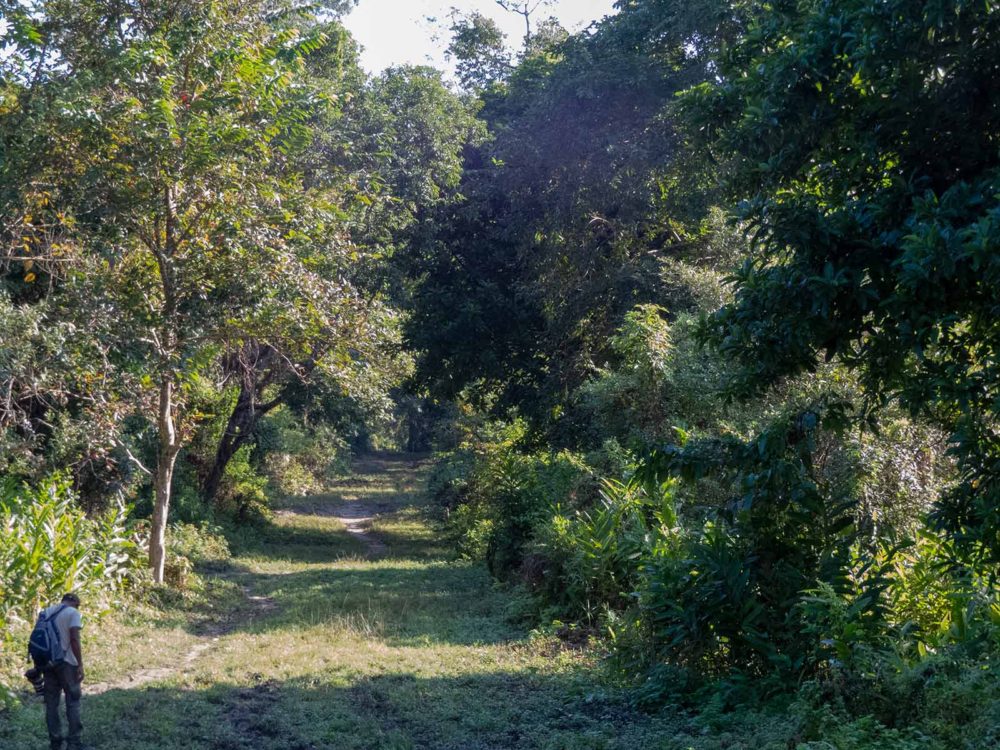
The trekking in Nameri National Park was very casual. The flat walk was an easy one but we took our time in watching the diverse amount of life in the park.
By the time we finished our trail and came back to the starting point , the weather was hot. We were straining our eyes to see what was infront of us in that harsh sunlight but the guard spotted a bird on a very tall tree. After some long struggle, we also found the bird sitting on that gigantic tree and it was the most sought Peregrine Falcon. We squinted our eyes and saw the bird through binocular amidst dense foliage. After seeing that far away bird, we wished to spent sometime on the shores and walked on the pebbles. Ibis bill was in Vinod’s wishlist but we were told they were not yet seen in that area for that season. Though we didn’t get to see the Ibis bill, we spotted the River Lapwing standing calmly amidst the pebbles. Unlike the Red-wattled Lapwing who gives alarm call for any movement, this River Lapwing stood still.
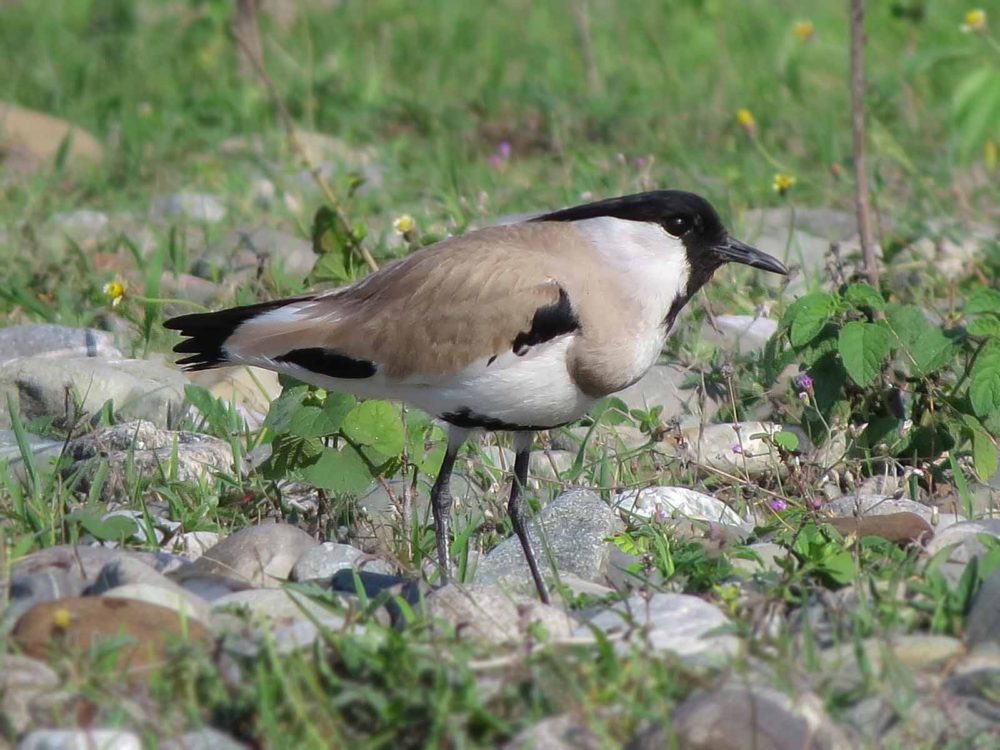
River lapwing is mainly seen foraging near river banks and hence the name. The bird raises its black crest during display.
We were very excited to see this lapwing which is also in Near Threatened Category. We returned back in boat and went back to our resort in our car. After eating some food as though we were famished for a long time , we walked around the resort. This place would have been more beautiful in rains but there would be floods in Jia-Bhoroli river during monsoon season which would make it extremely difficult to enter the Nameri National Park. So we selected this time of the year to roam around casually but we really wanted to see this place during rainy season.
Even inside the resort our birding did not stop , as we had Sind Sparrows who were constantly chirping and building nests on the roofs.
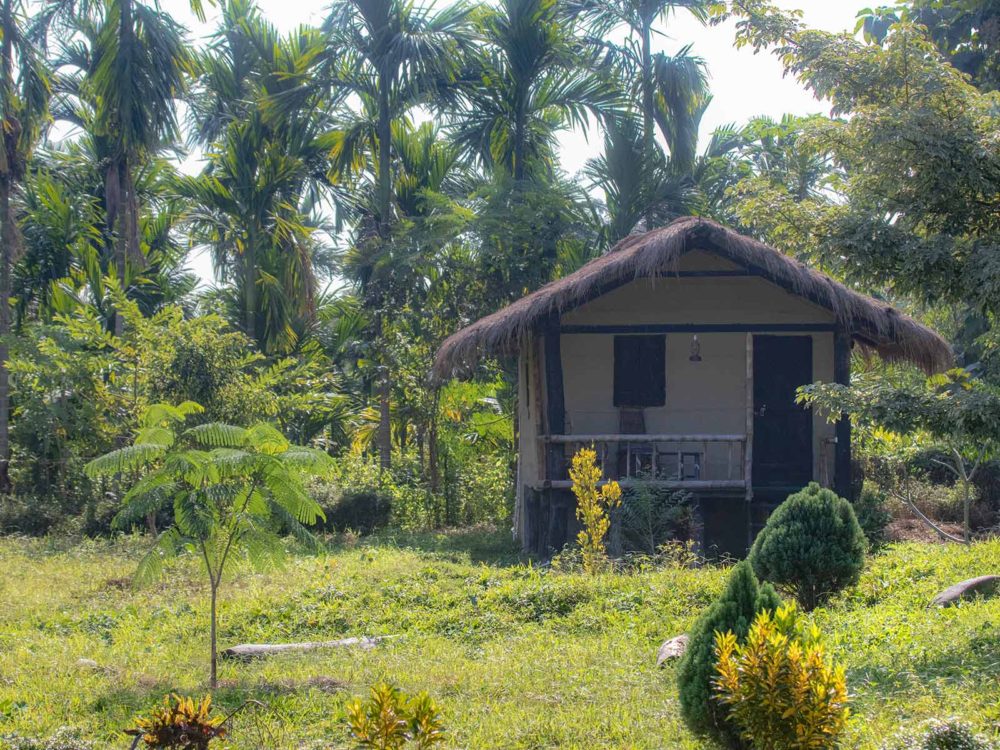
There were not many stays available near Nameri National Park. After some intense internet search, I found this eco camp and we were very satisfied with our stay.
We spent time watching them and then we went for a walk in the village even though it was hot. We didn’t even walked for 5 minutes but two dogs whom we saw in forest office earlier started following us. We couldn’t loose them at all and we had too many experiences to know that we could never do a birding when a dog tags you along.
So we decided to return back, but something on a tree in an open field caught our eye. Vinod went closer while I was handling the dogs. I knew from his expression it was an Owl and we took our turns to go near the tree while the other stood with the dogs. It was an Asian Barred Owlet and he didn’t flinch at our sight. He was well camouflaged but we somehow spotted him.
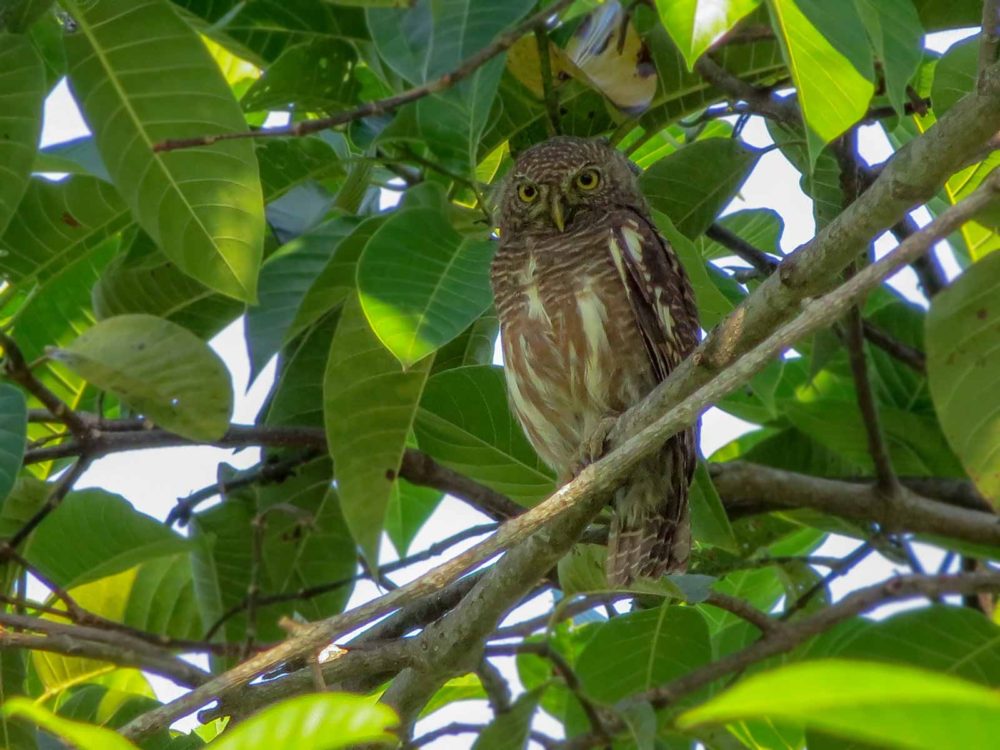
Asian barred owlet is one of the true owl species which can be seen during the day. The eyes of the owls always captivate us!
We decided to do village side birding in the evening and returned back to our stay.
We went for a stroll in the evening and surprisingly we saw quite a number of birds until the dogs came back. We saw Green-billed Malkoha, Pied Flycatcher, Bank Mynas and Ultra marine flycatcher. Vinod spotted few pigeons at distant and took some pictures for identification. We were distracted then by the two dogs who ran happily towards us. It looked like they identified the newcomers in the village and didn’t want to miss any fun. They both were playing with each other and seeking our attention too. I started playing with them while Vinod went behind birds. He saw a flock of Red-breasted parakeets again and few other flycatchers. Only when we returned back to the room and checked the photos we knew the pigeons we saw were Pin-tailed Green Pigeons! That was a lifer for us and we didn’t even know earlier because of those playful dogs. Anyway we were happy with that day in Nameri , so we didn’t want to end the day by grumbling about the White-winged ducks and Pin-tailed Green Pigeons.
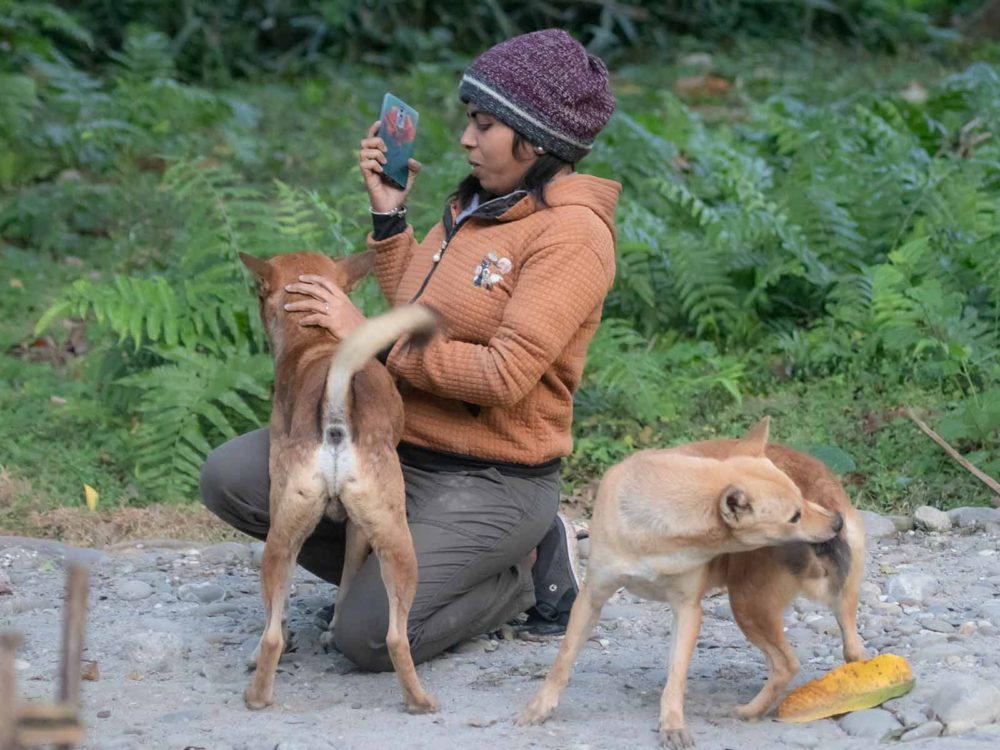
The dogs were jumping on me the whole time. Even though we love dogs, we don’t encourage stray dogs in wild places as they have ecological impact in the forests.
Next day we repeated our trek in Nameri National Park. Even if you walk the same trail again and again in the forest, you will be always surprised to see some unusual happenings in each visit. So we were walking with the same eagerness like the first day and we had one of the most memorable sightings in our North-east trip. We were very silent during our walk like the previous day, so we clearly heard the wing beat sound of the hornbills who flew above us. We thought it was the Rufous-necked hornbill which we had seen in Latpanchar but we were pleasantly surprised that it was the Wreathed hornbills.
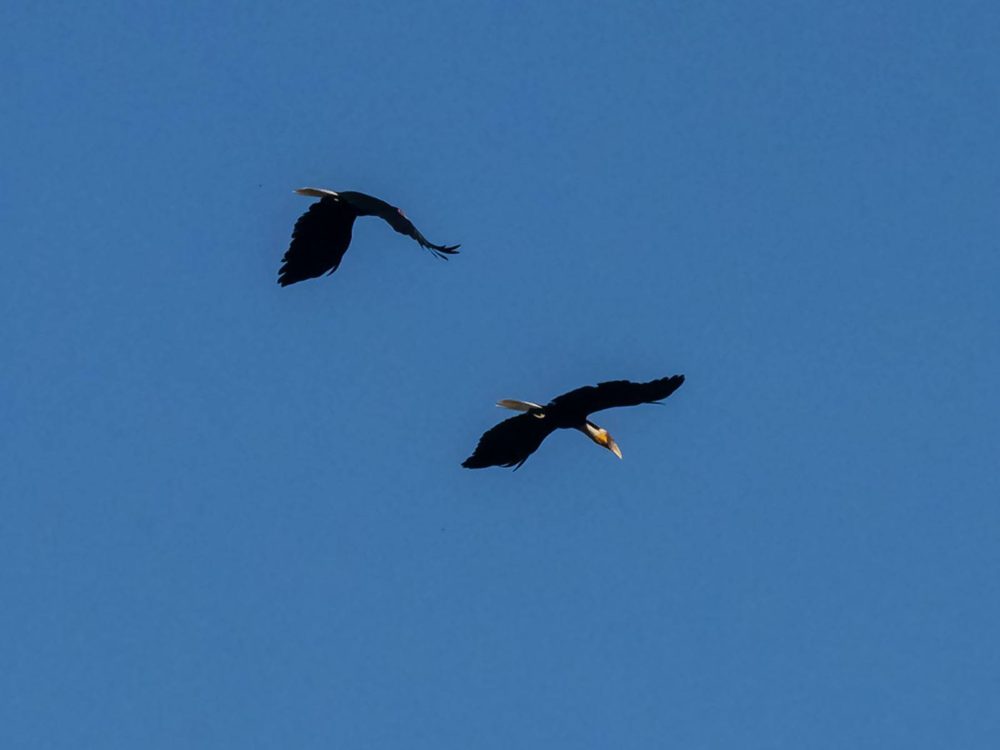
Hornbills are huge birds and they could be heard from some distance not only by their calls but also by the sound of their wing beats. Though they were quite high we could still hear the wing beats clearly.
Like the Capped Langurs and White-winged ducks , the status of this hornbill also questionable hence they are not commonly seen. Even the guard who regularly visits the park was surprised to know that the hornbills who flew above us were the Wreathed hornbills!
After sometime we stopped near a very old rainforest tree. While I was admiring the tree, Vinod spotted an interesting Gekko on the tree. I usually flinch at the sight of Gekkos but even I admitted that Tokay gecko looked attractive. It was huge for gekkos and the native habitat of the gekko is rainforest it seems. Later we saw the same species in Kaeng Krachan National Park, Thailand but on walls.

Coming from south we were used to seeing geckos that are small in size. When Vinod spotted this he was confused about the size and hence wasn’t even sure if it was a gecko. When we clarified with the forest guard we came to know about it’s enormous size – about 1 feet in length.
So seeing these Tokay gecko on an old tree was more attractive than the ones on the walls. We were sad to know that even these Tokay geckos were not left alone by poachers. They were poached for medicinal and pet trades. They were threatened species in Phillipines. In this Nameri we had seen many species hanging on a thread. By that, one can understand how precious this little national park at the foothills of Eastern Himalayas is ! We had a pleasant experience in Nameri National Park because of the diverse sightings of wildlife but at the same time very saddened to know about the “Threatened” Status of many species. The Nameri National Park is one of the last remaining homes for these species and it is in the hands of humans to protect this place from destruction.
North East is truly amazing!!
Here again except for the boat ride I did the same trek to Jio Boroli river. Did not encounter the elephant. Nostalgic
Super